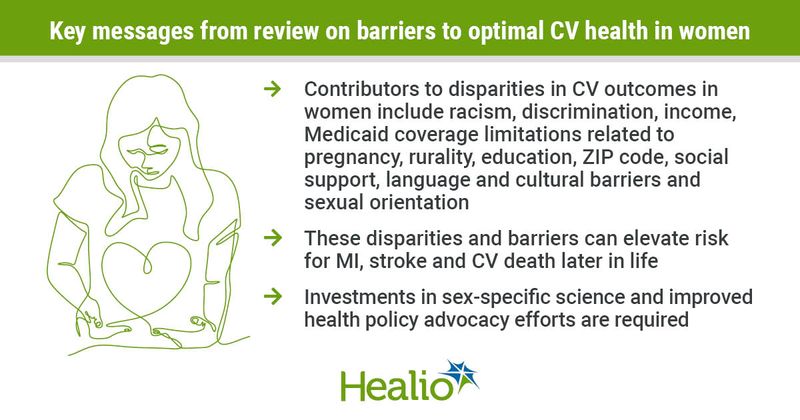Review: Many women face barriers to optimal CV health early in life
Socioeconomic barriers facing women, including poor access to contraception, postpartum follow-up and maternity leave, can impact their CV health over time, according to a new review.
The authors of the review, members of the American College of Cardiology Cardiovascular Disease in Women Committee and Health Equity Task Force, wrote that these barriers can elevate risk for MI, stroke and CV death later in life in the affected populations, particularly women from historically underrepresented backgrounds.

According to the review, published in the Journal of the American College of Cardiology, contributors to disparities in CV outcomes in women include racism, discrimination, income, Medicaid coverage limitations related to pregnancy, rurality, education, ZIP code, social support, language and cultural barriers, and sexual orientation.
Contributing factors are modifiable
In addition, they wrote, although it is known that 80% of CVD cases can be prevented through lifestyle modification, these barriers can make such modifications difficult.

“These contributing factors are often overlapping and, importantly, are modifiable with actionable solutions,” Kathryn J. Lindley, MD, FACC, chair of the ACC Cardiovascular Disease in Women Committee and associate professor of medicine and director of the Center for Women’s Heart Disease at Washington University School of Medicine in St. Louis, said in a press release. “Resolving health care outcomes disparities in women will require both investment in sex-specific science as well as health policy advocacy and incorporating awareness of the impact of these barriers into our health care delivery.”
Potential solutions
The review outlined the following potential solutions:
Diversify the cardiology work force, in which women and people from historically underrepresented backgrounds are underrepresented. “Lack of diversity among health care professionals may be even more responsible for disparities in health care access and outcomes than lack of health insurance,” Lindley and colleagues wrote.
Launch coordinated efforts to achieve optimal CV health in all women irrespective of race and ethnicity. “Suggested strategies include working with communities so that they have access to resources essential for healthy living, emphasizing patient-centered health and health promotion rather than treatment of disease, and promoting awareness of and building the political will to prioritize this issue,” the authors wrote.
Extend Medicaid coverage for 12 months after delivery, which may reduce cases of postpartum maternal CV mortality, facilitate CV screening during pregnancy and improve access to contraception.
Promote telemedicine consultation with CV professionals, which can improve access to providers among underserved groups, and use digital health technology to better formulate comprehensive care plans.
Conduct culturally tailored interventions to improve health literacy.
Provide access to interpreters for patients who do not speak English.
Recruit more women and people from historically underrepresented backgrounds into CV clinical trials.
Forge partnerships between health care institutions and community organizations. “To ensure equitable health care access for all women, a collaborative and integrated partnership between health care systems and community organizations is essential — and has previously been proved to reduce cardiovascular risk factors, including lipid levels, blood pressure, and glycated hemoglobin, and to improve mental health indexes among socioeconomically disadvantaged women,” Lindley and colleagues wrote.
Improve access to heart-healthy foods and exercise locations.
“Resolving health care outcomes disparities in women will require both investment in sex-specific science and health policy advocacy and incorporating awareness of the impact of these barriers into our health care delivery (on both personal and systemic levels),” Lindley and colleagues wrote.
